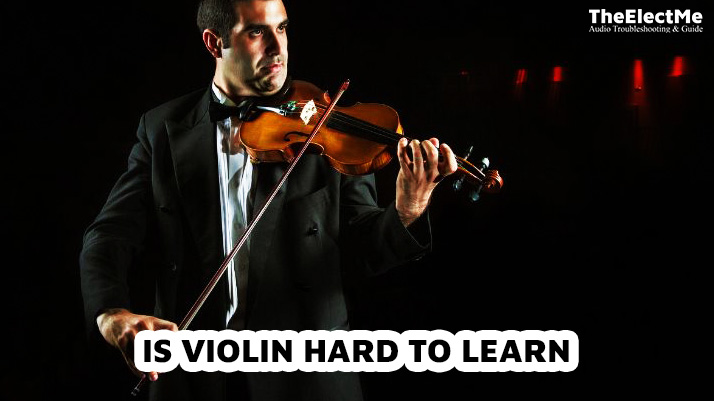Is violin hard to learn? Yes, the violin is a challenging instrument for beginners to learn. The violin is an instrument of beauty and complexity. It sings, it weeps, and it dances. Its music can evoke powerful emotions, stir the soul, and inspire listeners. But behind its enchanting sound and elegant appearance lies a steep learning curve.
Mastering the violin is no easy feat. It requires precision, dedication, and a deep understanding of music. With the right approach, guidance, and mindset, one can master the art of playing the violin.

Understanding The Complexity Of The Violin
The violin’s unique features often contribute to its perceived complexity. Unlike guitars and many other stringed instruments, violins lack frets. This means there are no visual aids to guide finger placement on the strings, making it harder to hit the right notes.
Another unique aspect is the precision required in playing the violin. The distances between notes on a violin are minimal. Slight finger position shifts can significantly alter pitch, necessitating sharp musical ear and finger dexterity.
When compared to other instruments, the violin presents a unique set of challenges. For instance, a piano has marked keys that produce a specific note when pressed, making it straightforward to play the correct notes. Similarly, a guitar has frets that provide a visual guide for finger placement.
On the contrary, a violinist must rely heavily on muscle memory and auditory feedback to find the right notes. The bowing technique also adds another layer of complexity. Bowing requires a smooth, controlled motion to produce a consistent sound, unlike plucking or striking. This combination of factors makes learning the violin more complex than most other instruments.
Now, let’s delve into the factors contributing to the inherent challenges of violin learning.
Is Violin Hard To Learn? 5 Factors That Make It Difficult
Here are five reasons why knowing the violin is considered a challenge:
1) Lack of Frets
One of the most distinguishing features of a violin is its lack of frets. This means there are no physical markers on the fingerboard to indicate where to place the fingers to produce specific notes.
Finding the correct pitch is up to the player’s ear and muscle memory. This feature significantly contributes to the difficulty of learning the violin, requiring precise finger placement.

2) Required Precision
Playing the violin demands an exceptional degree of precision. The distances between notes on the violin are minuscule, and even a slight movement can alter the pitch.
Therefore, violinists must develop excellent muscle control and a keen ear for music to play the correct notes consistently.

3) Physical Demands
The violin is a physically demanding instrument. Holding the violin correctly requires a specific posture that can be uncomfortable for beginners.
Drawing the bow across the strings requires precise pressure and speed, demanding strength and endurance.

4) Complex Bowing Techniques
Bowing techniques in violin playing are complex and varied. Each method must be mastered from legato (smooth, continuous bow strokes) to staccato (short, detached notes) to produce different musical effects. These techniques require understanding and a great deal of practice to execute correctly.
5) Reading Music Notation
Reading music notation for the violin can be challenging due to the range of pitches and rhythms the instrument can produce. Unlike some instruments where notes are written as they sound, violin music employs various position markings. This adds another layer of complexity to the learning process.

What Are Five Valuable Tips For Mastering The Violin Without Getting Overwhelmed?
Here are five tips to help you learn the violin without feeling overwhelmed:
1. Proper Posture
The first step to mastering the violin is developing a good playing posture. This includes positioning the violin correctly on the shoulder and holding the bow with a relaxed grip. It also involved maintaining an erect yet comfortable stance.
2. Tuning Regularly
Always ensure your violin is in tune before you start playing. This helps produce better sound and trains your ears to recognize the correct pitches.
3. Mastering Bowing Technique
Proper bowing is crucial for a beautiful tone. Practice keeping the bow parallel to the bridge and applying consistent pressure throughout the bow stroke.
4. Finger Placement
Placing your fingers in the exact spot on the string becomes critical without frets. Use tape or a finger guide initially to help with finger placement until you develop muscle memory.
5. Start Slow
Begin with simple scales and melodies. Take your time playing complex pieces. Gradually increase the difficulty as your skills improve.
Importance of Practice
The saying “practice makes perfect” especially applies when learning the violin. Regular and consistent practice is critical in mastering this instrument.

During practice sessions, focus on different aspects such as intonation, rhythm, bowing technique, and musicality. Remember, practice means playing the notes accurately while capturing and conveying the piece’s emotion. It’s sometimes about how long you practice but how effectively you use your practice time.
What Are A Few Fundamental Guidelines For Playing The Violin?
While there are no hard and fast rules for playing the violin, here are some general guidelines that can help you improve your skills:
Understand the Music Vocabulary
Learn the basic music notation terms like Quaver, Crochet, Minim, Semibreve, Tempo, and Rhythm. Understanding these terms will assist you in reading sheet music more efficiently.
Seek Professional Guidance
The violin is complex, and it’s easy to develop bad habits without proper guidance. Regular feedback from experienced teachers can expedite your learning process.
Keep Both Hands Active
Engage both hands from the beginning. This means coordinating the bowing hand with the fingering hand, which is crucial for playing the violin.
Master Basic Techniques
Work on fundamental techniques like proper bow hold, straight bowing, and first-position fingering. These techniques form the foundation of good violin playing.

Break Down Difficult Pieces
When practicing pieces, isolate and practice the challenging parts separately before integrating them into the whole work.
Use Technology
Use online violin apps and other digital resources to supplement your learning. These tools offer valuable practice aids, tutorials, and feedback.
Remember, learning the violin is a journey, not a race. Patience, perseverance, and passion are equally important as these rules.
Conclusion – Is Violin Hard to Learn?
Playing the violin is a disciplined, dedicated, and constant learning journey. Mastering this instrument can be challenging, given its intricacies and the level of precision it demands. Every aspect requires patience and practice, from maintaining good posture to coordinating bowing and fingering.
Remember, every violinist started where you are now, from beginners to virtuosos. They, too, faced the same challenges and overcame them with time and persistence. So, if you’re considering learning the violin, embrace the challenge. Take a deep breath, pick up your violin, and let the music guide you.



